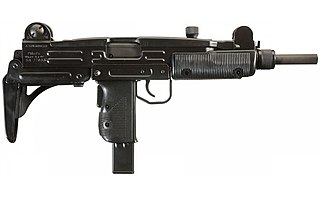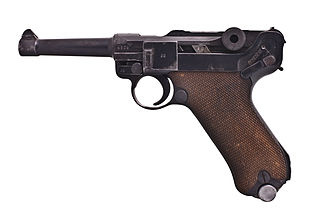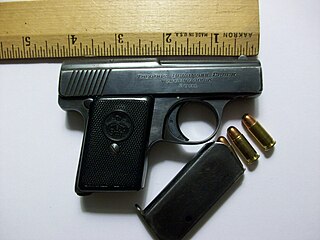
A machine pistol is an autoloading pistol capable of fully automatic fire, including stockless handgun-style submachine guns.

A submachine gun (SMG) is a magazine-fed automatic carbine designed to fire handgun cartridges. The term "submachine gun" was coined by John T. Thompson, the inventor of the Thompson submachine gun, to describe its design concept as an automatic firearm with notably less firepower than a machine gun. As a machine gun must fire rifle cartridges to be classified as such, submachine guns are not considered machine guns.

The Uzi is a family of Israeli open-bolt, blowback-operated submachine guns and machine pistols first designed by Major Uziel "Uzi" Gal in the late 1940s, shortly after the establishment of the State of Israel. It is one of the first weapons to incorporate a telescoping bolt design, which allows the magazine to be housed in the pistol grip for a shorter weapon.

The Pistole Parabellum or Parabellum-Pistole, commonly known as just the Luger or Luger P08, is a toggle-locked recoil-operated semi-automatic pistol. The Luger was produced in several models and by several nations from 1898 to 1949.

The Colt M1911 is a single-action, recoil-operated, semi-automatic pistol chambered for the .45 ACP cartridge. The pistol's formal U.S. military designation as of 1940 was Automatic Pistol, Caliber .45, M1911 for the original model adopted in March 1911, and Automatic Pistol, Caliber .45, M1911A1 for the improved M1911A1 model which entered service in 1926. The designation changed to Pistol, Caliber .45, Automatic, M1911A1 in the Vietnam War era.
Carl Walther GmbH Sportwaffen, or simply known as Walther, is a German firearm manufacturer, and a subsidiary of the PW Group. Founded by Carl Walther in 1886, the company has manufactured firearms and air guns at its facility in Germany for more than 100 years. Walther Arms, Inc. is the United States Walther business unit and is based in Fort Smith, Arkansas.

The Mauser C96 is a semi-automatic pistol that was originally produced by German arms manufacturer Mauser from 1896 to 1937. Unlicensed copies of the gun were also manufactured in Spain and China in the first half of the 20th century.

The Military Armament Corporation Model 10, officially abbreviated as "M10" or "M-10", and more commonly known as the MAC-10, is a compact, blowback operated machine pistol/submachine gun that was developed by Gordon B. Ingram in 1964. It is chambered in either .45 ACP or 9mm. A two-stage suppressor by Sionics was designed for the MAC-10, which not only abates the noise created but makes it easier to control on full automatic.

The Beretta Model 1934 is an Italian compact, semi-automatic pistol which was issued as the service pistol of the Royal Italian Army beginning in 1934. As the standard sidearm of the Italian army it was issued to officers, NCOs and machine gun crews. It is chambered for the 9mm Corto, more commonly known as the .380 ACP.

The Walther PP series pistols are blowback-operated semi-automatic pistols, developed by the German arms manufacturer Carl Walther GmbH Sportwaffen.

The TT-30, commonly known simply as the Tokarev, is a Soviet semi-automatic pistol. It was developed in 1930 by Fedor Tokarev as a service pistol for the Soviet military to replace the Nagant M1895 revolver that had been in use since the Russian Empire, though it ended up being used in conjunction with, rather than replacing, the M1895. It served with the Soviet Armed Forces until 1952, when it was replaced by the Makarov pistol.
The MP34 is a submachine gun (SMG) that was manufactured by Waffenfabrik Steyr as Steyr-Solothurn S1-100 and used by the Austrian Army and Austrian Gendarmerie and subsequently by units of the German Army and the Waffen SS, in World War II. An exceptionally well-made weapon, it was used by some forces well into the 1970s.

The FN Browning M1900 is a single action semi-automatic pistol designed c. 1896 by John Browning for Fabrique Nationale de Herstal (FN) and produced in Belgium at the turn of the 20th century. It was the first production handgun to use a slide.

The FN Model 1910 is a blowback-operated, semi-automatic pistol designed by John Browning and manufactured by Fabrique Nationale of Belgium.

Star Bonifacio Echeverria, S.A. was a manufacturer of small arms in the Basque region of Spain from about 1905 until 1997.

The MAB model D is a pistol produced by MAB from 1933 to 1963 and 1982 ; it was inspired by the Belgian Browning FN pistol 1910/22.

The FN Model 1903, or Browning No.2 is a semi-automatic pistol designed by John Browning and manufactured by Belgian arms manufacturer Fabrique Nationale (FN). It was introduced in 1903 and fired the 9×20mmSR Browning Long cartridge. It should not be confused with the US-made Colt Model 1903 Pocket Hammerless, nor with the Colt Model 1903 Pocket Hammer. The FN Model 1903 is based on the same mechanical design as the Colt Model 1903 Pocket Hammerless, which Browning sold to both companies, but enlarged to handle the more powerful 9mm Browning Long cartridge. The M1903's reliability, accuracy, light weight, and quick reloading made it a popular service pistol for many police forces and militaries. The pistol was initially introduced by FN as the Browning Modèle de Guerre or Browning Grand Modèle.

Designed and popularized by the Austrian watchmaker Franz Pfannl. The 4.25 mm Liliput pistol is one of the smallest semiautomatic handguns ever made. Hence its name, derived from the fictional island of Lilliput, inhabited by tiny people.

Glock is a brand of polymer-framed, short recoil-operated, locked-breech semi-automatic pistols designed and produced by Austrian manufacturer Glock Ges.m.b.H.

The 9×25mm Mauser is a cartridge developed for the Mauser C96 service pistol around 1904 by DWM. Mauser pistols in this relatively powerful caliber were primarily intended for export to Africa, Asia, and South America. The 9mm Mauser Export cartridge was produced specifically for Mauser pistols and carbines made from 1904 to 1914 and then later from approximately 1930 to 1945 for submachine guns chambered for this caliber.


















